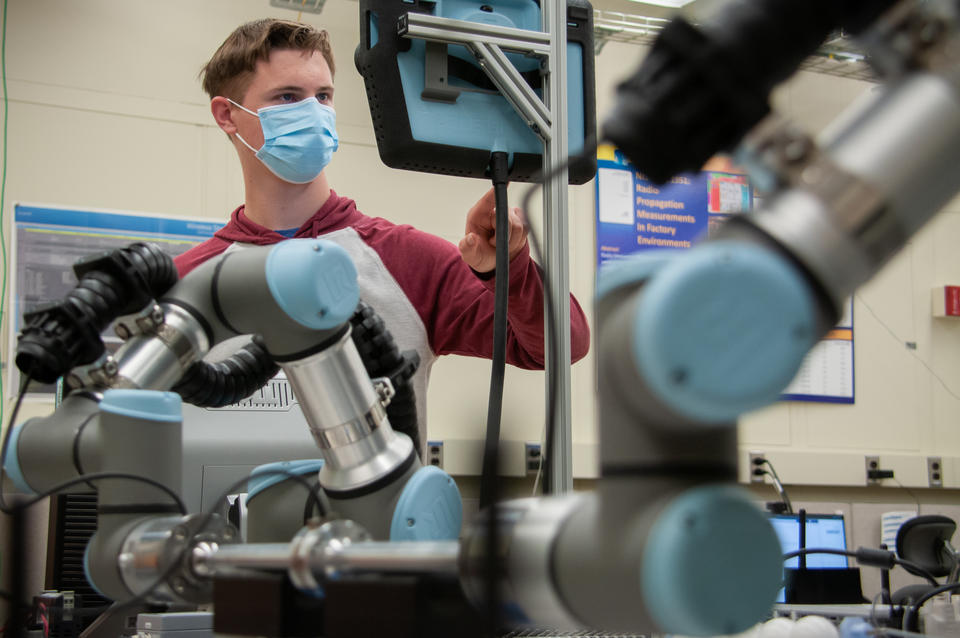Taking Measure
Just a Standard Blog

After an online summer internship at NIST, Steven Salisbury was able to visit the Gaithersburg campus. Here he uses computer code that he wrote during his internship to manipulate robotic arms in the lab.
For nine years, I have been obsessed with the Rubik’s Cube. It is a puzzle that has simultaneously stumped and interested the whole world since it was first invented, something few other puzzles can claim. However, while most people are satisfied after solving the cube once, I wasn’t. I wanted to understand what I did, not just read it from a book. So I went to the internet and started down the rabbit hole. I learned new methods and algorithms. I learned not just how to solve it but why the methods worked, and I learned the logic associated with the manipulation of the cube.
As I got older, that love to learn and understand mechanisms and puzzles expanded into other fields. It extended beyond the Rubik’s Cube into realms of engineering. From making Lego robots to researching Formula One cars, the things I enjoyed were all connected by the ideas and techniques that engineering covered, and so as I entered my junior year of high school, I began looking for opportunities to get some experience.
So when I heard about the NIST Summer High School Intern Program (SHIP), it seemed like a golden opportunity to gain real-world engineering experience and understanding with top experts in the field while growing my passion for problem solving. Naturally, I applied to NIST’s Engineering Laboratory for the program, and was excited when I was selected to intern with the Industrial Wireless Systems team.
So last summer, I spent my time virtually working on collaborative robotic systems that use a wireless connection. Basically, two robot arms need to do a task together while communicating wirelessly. Robotic arms have been working together in factories and production processes for years now, but they’re almost always connected by wired communication lines to reduce the amount of interference between signals and minimize latency, the time delay in sending and receiving data. This has a drawback, though. With wired communications, clutter and wires can get in the way and become a serious issue as processes scale up in size and complexity. In contrast, with wireless communication, organizing and creating space for a collaborative robotic system becomes much easier. But that happens at the expense of interference and latency.
The challenge for the team was (and still is) to find ways to minimize these issues with wireless communication to make collaborative wireless systems effective and efficient in the industrial sector. My job specifically was to make a measurement tool, in this case, a piece of software that could measure the positioning error between where a robotic arm is and where it is supposed to be. The reason this is useful is that when testing different latency-reducing mechanisms, the engineers need a concrete, objective measure of how quickly and accurately the robotic arms are moving to where they need to be. The tool I was tasked to create filled that need.
During the course of the summer internship period, I worked closely with the team, building code on my end and then reviewing and changing it, fixing it when something seemed off, and improving its efficiency until it could be effectively implemented by the system. Seeing my work implemented in the real world, being used and being useful, was incredibly rewarding, and it pushed me to continue improving and optimizing my code.
I learned a lot from this opportunity. I already knew how to code, but I learned how to take a list of requirements and turn it into a real product. I already knew how to debug my programs, but I learned how to do optimizations with testing results, looking at what was not fast enough or efficient enough during a test and fixing it. More than that, I pushed myself to try and make it even better, even if someone had already deemed it “good enough.” If it’s fast, how can it be faster? If it’s efficient, how can I improve its performance? Nothing is ever truly optimized, and I learned the importance of seeking out not just the big improvements but also the little ones.
I got the chance to visit NIST’s Gaithersburg, Maryland, campus after my internship term was over, and seeing the robotic arms in person, watching my code work, gave me new ideas of what I can improve and great insight into what I should focus on. Working at NIST, talking and collaborating with the experts, helped me confirm my love for engineering and problem solving. The SHIP internship program is a golden opportunity for students like me to learn, not just about the work, but about ourselves and our interests, and I hope to use this experience again.





